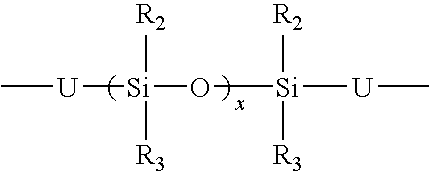Organosilicon-polyurea base polymer, elastomer prepared therefrom, preparation thereof and use of the same
a technology of organosilicon and polyurea, which is applied in the field of self-crosslinking organosiliconpolyurea base polymer, elastomer preparation therefrom, and the preparation thereof, can solve the problems of increasing the requirements of volatile organic content of such materials used as sealants, the need for such sealant materials continues to exist, and the method of preparation of such materials is complicated. , to achieve the effect of simple and direct preparation of polymer materials, and increasing the mo
- Summary
- Abstract
- Description
- Claims
- Application Information
AI Technical Summary
Benefits of technology
Problems solved by technology
Method used
Image
Examples
example 1
[0090]In a vessel with agitator, 200 g aminopropyl dimethyl terminated polydimethylsiloxane (Mw=1000; 0.4 moles amino groups, Gelest Co.) was dissolved with 1 L solvent (toluene:THF=1:1, volume ratio), to which 66.6 g IPDI (0.6 moles NCO) was added before allowing the system to react at 40° C. for 2 hr. After adding 26.4 g aminoethyl aminopropyl triethoxy silane (0.2 moles amino groups, TM-552, Wuhan Tianmu Science and Technology Co., 96# South Road of Zhuodaoquan, Hongshan District, Wuhan City, China,), the system continuously reacted at 40° C. for 4 hr. The reaction was carried out under N2 protection at 1.01 atm. A solution sol of organosilicon-polyurea base polymer having a molar ratio of components A:B:C=3:2:1 was finally prepared. The solution sol was poured to form a film, which was cured and crosslinked at room temperature to obtain an elastomertic material. The base polymer, prior to crosslinking, had a weight average molecular weight of 1×105. The elastomeric material had ...
example 2
[0091]In a dual-cartridge extruding gun (Loctite® Dual Cartridge Manual Applicators, model 983438, with a volume ratio of A:B=10:1, manufactured by Henkel Co.), 300.0 g aminopropyl dimethyl terminated polymethylphenylsiloxane (Mw=3000; 0.2 mol amino groups, made by referring to James E. McGrath, Debra L. Dunson, Sue J. Mechaml, James L. Hedrick, Advances in Polymer Science, Vol. 140, 1999, 62-99) was added to A; and 33.6 g cyclohexylene diisocyanate (0.4 moles NCO,) and 19.6 g aminoethyl aminopropyl methyldimethoxy silane (TM-602, 0.2 mol amino groups, Wuhan Tianmu Science and Technology Co.) as well as 0.005 g stannous caprylate (Shanghai Qidi Chemical Industry Co., Ltd., 2299# North Road of Zhongshan, Shanghai City, China) were added to B. The forehead mixer of the extruding gun is φ 8 mm static mix nozzles Part No. 983443. By virtue of extrusion at room temperature, an elastomeric material from organosilicon-polyurea base polymer having a molar ratio of components A:B:C=2:1:1 was...
example 3
[0092]In a vessel with agitator, 475 g aminopropyl dimethyl terminated polydimethylsiloxane (Mw=5000; 0.19 moles amino groups, made by referring to the same document as given in Example 2) was dissolved with 1 L solvent (DMF:THF=1:2, volume ratio), to which 25 g MDI (0.20 moles NCO) was added before allowing the system to react at 50° C. for 1 hr. After adding 1.11 g aminoethyl aminopropyl methyldimethoxy silane (0.01 moles amino groups, primary amino groups plus secondary amino groups, TM551, Wuhan Tianmu Science and Technology Co.), the system continuously reacted at 50° C. for 4 hr. The reaction was carried out under N2 protection at 1.05 atm. A solution sol of organosilicon-polyurea base polymer having a molar ratio of components A:B:C=20:19.1 was finally prepared. The solution sol was poured to form a film, which was cured and crosslinked at room temperature to obtain an elastomertic material. The base polymer, prior to crosslinking, had a weight average molecular weight of 8×1...
PUM
| Property | Measurement | Unit |
|---|---|---|
| molecular weight distribution index | aaaaa | aaaaa |
| temperature | aaaaa | aaaaa |
| boiling point | aaaaa | aaaaa |
Abstract
Description
Claims
Application Information
 Login to View More
Login to View More - R&D
- Intellectual Property
- Life Sciences
- Materials
- Tech Scout
- Unparalleled Data Quality
- Higher Quality Content
- 60% Fewer Hallucinations
Browse by: Latest US Patents, China's latest patents, Technical Efficacy Thesaurus, Application Domain, Technology Topic, Popular Technical Reports.
© 2025 PatSnap. All rights reserved.Legal|Privacy policy|Modern Slavery Act Transparency Statement|Sitemap|About US| Contact US: help@patsnap.com



